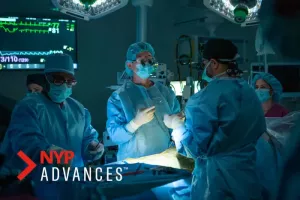Health Library
Malignant Mesothelioma Treatment (Adult) (PDQ®): Treatment - Patient Information [NCI]
- General Information About Malignant Mesothelioma
- Stages of Malignant Mesothelioma
- Treatment Option Overview
- Treatment of Localized Malignant Mesothelioma (Stage I)
- Treatment of Advanced Malignant Mesothelioma (Stages II, III, and IV)
- Treatment of Recurrent Malignant Mesothelioma
- To Learn More About Malignant Mesothelioma
- About This PDQ Summary
General Information About Malignant Mesothelioma
Malignant mesothelioma is a type of cancer that forms in the thin layer of tissue that covers organs in the chest or abdomen.
Malignant mesothelioma may be found in one or more of the following:
- the pleura, a thin layer of tissue that lines the chest cavity and covers the lungs
- the peritoneum, a thin layer of tissue that lines the abdomen and covers most of the organs in the abdomen
- the pericardium, a thin layer of tissue that surrounds the heart
Malignant mesothelioma may also form in the heart or testicles, but this is rare.
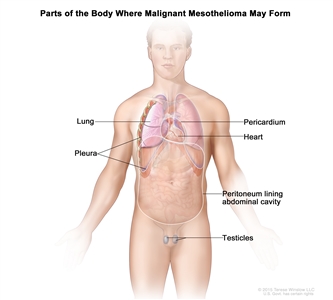
Malignant mesothelioma forms in the tissue that lines the chest or abdomen, including the pleura (the tissue that lines the chest cavity and covers the lungs) and the peritoneum (the tissue that lines the abdomen and covers most of the organs in the abdomen). Malignant mesothelioma may also form in the pericardium (the tissue that surrounds the heart) or the testicles, but this is rare.
Being exposed to asbestos can increase the risk of malignant mesothelioma.
Malignant mesothelioma is caused by certain changes to the way the cells that line the organs function, especially how they grow and divide into new cells. Often, the exact cause of the cell change is unknown. Learn more about how cancer develops at What Is Cancer?
A risk factor is anything that increases the chance of getting a disease. Most people with malignant mesothelioma have worked or lived in places where they inhaled or swallowed asbestos, which has been used in the building and textile industries. After being exposed to asbestos, it usually takes a long time for malignant mesothelioma to form. Living with a person who works near asbestos is also a risk factor for malignant mesothelioma. Not every person with one or more of these risk factors will develop malignant mesothelioma. And it can develop in some people who don't have any known risk factors.
Talk to your doctor if you think you may be at risk.
Signs and symptoms of malignant mesothelioma include shortness of breath and pain under the rib cage.
Sometimes the cancer causes fluid to collect in the chest or in the abdomen. Signs and symptoms may be caused by the fluid, malignant mesothelioma, or other conditions. Check with your doctor if you have any of the following:
- trouble breathing
- cough
- pain under the rib cage
- pain or swelling in the abdomen
- lumps in the abdomen
- constipation
- problems with blood clots (clots form when they shouldn't)
- weight loss for no known reason
- fatigue (feeling very tired)
Tests that examine the inside of the chest and abdomen are used to diagnose malignant mesothelioma.
Sometimes it is hard to tell the difference between malignant mesothelioma in the chest and lung cancer. If you have symptoms that suggest mesothelioma, the doctor will need to find out if these are due to cancer or to another problem. The doctor will ask when the symptoms started and how often you have been having them. They will also ask about your personal and family health history and do a physical exam. Depending on these results, they may recommend other tests. If you are diagnosed with mesothelioma, the results of these tests will help you and your doctor plan treatment.
The tests and procedures used to diagnose mesothelioma may include:
- Chest x-ray is a type of radiation that can go through the body and make pictures of the organs and bones inside the chest.
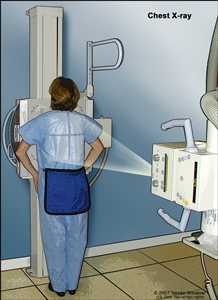
A chest x-ray is used to take pictures of the structures and organs inside the chest. X-rays pass through the patient's body onto film or a computer. - CT scan (CAT scan) uses a computer linked to an x-ray machine to make a series of detailed pictures of areas inside the body. The pictures are taken from different angles and are used to create 3-D views of tissues and organs. A dye may be injected into a vein or swallowed to help the organs or tissues show up more clearly. This procedure is also called computed tomography, computerized tomography, or computerized axial tomography. Learn more at Computed Tomography (CT) Scans and Cancer.
- Biopsy is the removal of cells or tissues from the pleura or peritoneum so that a pathologist can view it under a microscope to check for signs of cancer.
Procedures used to collect the cells or tissues include:
- Fine-needle (FNA) aspiration biopsy of the lung uses a thin needle to remove tissue or fluid. An imaging procedure is used to locate the abnormal tissue or fluid in the lung. A small incision may be made in the skin where the biopsy needle is inserted into the abnormal tissue or fluid, and a sample is removed.
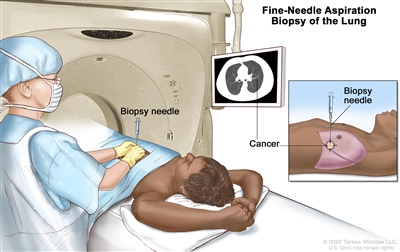
Fine-needle aspiration biopsy of the lung. The patient lies on a table that slides through the computed tomography (CT) machine, which takes x-ray pictures of the inside of the body. The x-ray pictures help the doctor see where the abnormal tissue is in the lung. A biopsy needle is inserted through the chest wall and into the area of abnormal lung tissue. A small piece of tissue is removed through the needle and checked under the microscope for signs of cancer. - Thoracoscopy is surgery to look at the organs inside the chest to check for abnormal areas. An incision (cut) is made between two ribs and a thoracoscope (a thin, tube-like instrument with a light and a lens for viewing) is inserted into the chest.
- Thoracotomy is surgery to look inside the chest. An incision (cut) is made between two ribs to check inside the chest for signs of disease.
- Peritoneoscopy is surgery to look inside the abdomen. An incision (cut) is made in the abdominal wall and a peritoneoscope (a thin, tube-like instrument with a light and a lens for viewing) is inserted into the abdomen to check for signs of disease.
- Open biopsy is surgery to remove abnormal tissues so a pathologist can check it under a microscope for signs of disease. An incision (cut) is made through the skin to expose and remove tissues.
The following tests may be done on the cells and tissue samples that are taken:
- A cytologic exam is a laboratory test to view cells under a microscope to check for anything abnormal. For mesothelioma, fluid is taken from the chest or from the abdomen. A pathologist checks the fluid for signs of cancer.
- Immunohistochemistry is a laboratory test that uses antibodies to check for certain antigens (markers) in a sample of a patient's tissue. The antibodies are usually linked to an enzyme or a fluorescent dye. After the antibodies bind to a specific antigen in the tissue sample, the enzyme or dye is activated, and the antigen can then be seen under a microscope. This type of test is used to help diagnose cancer and to help tell one type of cancer from another type of cancer.
- Electron microscopy is a laboratory test in which cells in a sample of tissue are viewed under a high-powered microscope to look for certain changes in the cells. An electron microscope shows tiny details better than other types of microscopes.
- Fine-needle (FNA) aspiration biopsy of the lung uses a thin needle to remove tissue or fluid. An imaging procedure is used to locate the abnormal tissue or fluid in the lung. A small incision may be made in the skin where the biopsy needle is inserted into the abnormal tissue or fluid, and a sample is removed.
After malignant mesothelioma has been diagnosed, tests are done to find out if cancer cells have spread to other parts of the body.
The process used to find out if cancer has spread outside the pleura or peritoneum is called staging. The information gathered from the staging process determines the stage of the disease. It is important to know whether the cancer has spread in order to plan treatment.
The following tests and procedures may be used in the staging process:
- CT scan (CAT scan) uses a computer linked to an x-ray machine to make a series of detailed pictures of areas inside the body, such as the chest and abdomen. The pictures are taken from different angles and are used to create 3-D views of tissues and organs. A dye may be injected into a vein or swallowed to help the organs or tissues show up more clearly. This procedure is also called computed tomography, computerized tomography, or computerized axial tomography. Learn more at Computed Tomography (CT) Scans and Cancer.
- PET scan (positron emission tomography scan) uses a small amount of radioactive sugar that is injected into a vein. The PET scanner rotates around the body to make detailed, computerized pictures of areas inside the body where the glucose is taken up. Because cancer cells often take up more glucose than normal cells, the pictures can be used to find cancer cells in the body.
- MRI (magnetic resonance imaging) uses a magnet, radio waves, and a computer to make a series of detailed pictures of areas inside the body. This procedure is also called nuclear magnetic resonance imaging (NMRI).
- Endoscopic ultrasound (EUS) is a procedure in which an endoscope is inserted into the body. An endoscope is a thin, tube-like instrument with a light and a lens for viewing. A probe at the end of the endoscope is used to bounce high-energy sound waves (ultrasound) off internal tissues or organs and make echoes. The echoes form a picture of body tissues called a sonogram. This procedure is also called endosonography. EUS may be used to guide fine-needle aspiration (FNA) biopsy of the lung, lymph nodes, or other areas.
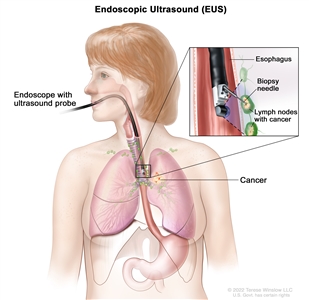
Endoscopic ultrasound-guided fine-needle aspiration biopsy. An endoscope that has an ultrasound probe and a biopsy needle is inserted through the mouth and into the esophagus. The probe bounces sound waves off body tissues to make echoes that form a sonogram (computer picture) of the lymph nodes near the esophagus. The sonogram helps the doctor see where to place the biopsy needle to remove tissue from the lymph nodes. This tissue is checked under a microscope for signs of cancer. - Laparoscopy is surgery to look at the organs inside the abdomen to check for signs of disease. Small incisions (cuts) are made in the wall of the abdomen and a laparoscope (a thin, lighted tube) is inserted into one of the incisions. Other instruments may be inserted through the same or other incisions to perform procedures such as taking tissue samples to be checked under a microscope for signs of disease.
- Lymph node biopsy is the removal of all or part of a lymph node. A pathologist views the lymph node tissue under a microscope to check for cancer cells.
- Mediastinoscopy is surgery to look at the organs, tissues, and lymph nodes between the lungs for abnormal areas. An incision (cut) is made at the top of the breastbone and a mediastinoscope is inserted into the chest. A mediastinoscope is a thin, tube-like instrument with a light and a lens for viewing. It may also have a tool to remove tissue or lymph node samples, which are checked under a microscope for signs of cancer.
Some people decide to get a second opinion.
You may want to get a second opinion to confirm your cancer diagnosis and treatment plan. If you seek a second opinion, you will need to get medical test results and reports from the first doctor to share with the second doctor. The second doctor will review the pathology report, slides, and scans. They may agree with the first doctor, suggest changes or another treatment approach, or provide more information about your cancer.
Learn more about choosing a doctor and getting a second opinion at Finding Cancer Care. You can contact NCI's Cancer Information Service via chat, email, or phone (both in English and Spanish) for help finding a doctor, hospital, or getting a second opinion. For questions you might want to ask at your appointments, visit Questions to Ask Your Doctor About Cancer.
Certain factors affect prognosis (chance of recovery) and treatment options.
The prognosis and treatment options depend on:
- the stage of the cancer
- the size of the tumor
- whether the tumor can be removed completely by surgery
- the amount of fluid in the chest or abdomen
- the patient's age
- the patient's activity level
- the patient's general health, including lung and heart health
- the type of mesothelioma cells and how they look under a microscope
- the number of white blood cells and how much hemoglobin is in the blood
- whether the patient is male or female
- whether the cancer has just been diagnosed or has recurred (come back)



